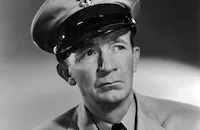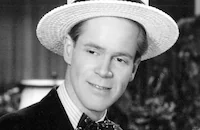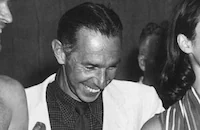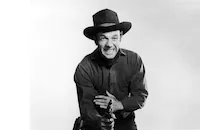The Pride of the Yankees

Brief Synopsis
Cast & Crew
Sam Wood
Gary Cooper
Teresa Wright
Babe Ruth
Walter Brennan
Dan Duryea
Film Details
Technical Specs

Synopsis
In the 1910s, young Henry Lou Gehrig, the son of German immigrants, yearns to play baseball, but his mother, who is a cook at Columbia University, wants him to become an engineer. Years later, when Lou is enrolled at Columbia, he is popular with other students and excels in all sports, even though he must work as a waiter in his fraternity house. When sports writer Sam Blake observes Lou's excellence at baseball, he begins to write about him. One day, Sam goes to the fraternity to see if Lou is interested in playing ball for the New York Yankees. Because some of the other boys had just played a trick on him, Lou thinks that Sam is part of the ruse and throws him out. Later, when he learns that Sam is genuine, Lou is pleased by the offer, but sheepishly declines, saying that he is going to be an engineer. One night, Lou's mother becomes gravely ill and must go to the hospital. Worried that his mother will not get the care she needs in a charity ward, Lou secretly signs with the Yankees to earn enough money to keep her in a private hospital. While she recovers, Lou and his father let her believe that he has enrolled at Harvard, when he actually is playing for the Yankees' farm team in Hartford. Lou soon becomes known for his hard work and consistent performance on the diamond, and within a short time is recalled by the Yankees. Mrs. Gehrig is at first angry and disappointed when she learns the truth, because she wants Lou to take advantage of other opportunities that America offers, but soon accepts her son's decision. The shy, but affable Lou eventually becomes the team's first baseman, and Sam, who is his strongest supporter, becomes his roommate on the road and tells rival sportswriter Hank Hannemann that Lou epitomizes what is best about baseball and America. In Chicago, Lou meets Eleanor Twitchell, the daughter of a wealthy hot dog manufacturer, and is smitten when she playfully dubs him "Tanglefoot" after he trips on some bats. When the team next travels to Chicago, Lou asks Eleanor out and soon the two fall in love. Despite Mrs. Gehrig's jealousy over not remaining Lou's "best girl," he proposes to Eleanor. Although at first Lou's mother tries to usurp Eleanor's position, Lou smooths things over and assures Eleanor that she is the manager of their team. As the years pass, the "Iron Horse," as the sports writers call Lou, remains happy in his career and marriage. In 1938, shortly after Lou is honored for playing in his 2,000th consecutive game, he begins to notice a strange weakness in his arms. His playing and coordination worsen, and by the 1939 season, his performance has become so poor that he is benched for the first time in his career. Lou goes for medical tests and learns that he must give up baseball, and when he asks "is it three strikes?" the doctor confirms Lou's fears. Lou does not want Eleanor to know that his illness is fatal, and although she guesses the truth, she maintains the pretense that he will recover. With his career over, Lou is honored at a special ceremony held at Yankee Stadium. In front of thousands of fans, and standing beside former teammates, Lou delivers a humble speech praising his family and colleagues. He ends by saying, "People all say that I've had a bad break. But today--today, I consider myself the luckiest man on the face of the earth."

Director

Sam Wood
Cast

Gary Cooper

Teresa Wright
Babe Ruth

Walter Brennan

Dan Duryea
Elsa Janssen

Ludwig Stossel

Virginia Gilmore
Bill Dickey
Ernie Adams

Pierre Watkin
Harry Harvey
Robert W. Meusel
Mark Koenig
Bill Stern

Addison Richards

Hardie Albright
Edward Fielding
George Lessey
Edgar Barrier
Douglas Croft
Gene Collins
David Holt
Veloz And Yolanda
Ray Noble
Bettye Avery
Vaughan Glaser
Garry Owen
Walter Anthony
Donald Kerr
Cyril Ring
Jack Chapin
John Ince
Frank Faylen
Lane Chandler
Rip Russell
Roy Brent
Ben Taggart
Jack Shea
George Mcdonald
Earle Hodgins
Malcolm Waite
Charles Williams
Matt Mchugh
Jack Gardner

Charles Irwin
Ilene Brewer
Rebecca Bohanon
Pat Lane
Porter Chase
Don Brodie
Bill Chaney
Clancy Cooper
Eddy Chandler
Ed Agresti
Mitchell Ingraham
Burr Caruth
John B. Old
Richard Kipling
Eva Dennison
Montague Shaw
Jack Stewart
Irving Mitchell
Pat Flaherty
Fay Thomas
Guy Wilkerson

Howard Mitchell
Sheldon Jett
Lestor Dorr
Henry Roquemore
Mary Gordon
John Hiestand
Francis Sayles
Hal Cooke
Walter Fenner
Buddy Williams
Hooper Atchley
Lynton Brent
Peter Du Rey
Eddie Hall
Ralph Mccullough
Johnny Day
George Offerman Jr.
Allen Wood
David Manley
John Merkyl
James Farley
Fay Holderness

James Westerfield
Rex Lease
Lorna Dunn
Max Willenz
J. Pat Moriarty
Ed Peil Sr.
Emory Parnell
Anita Bolster
Robert Winkler
Jimmy Valentine
Spencer Charters
Rosina Galli
Billy Roy
Sarah Padden
Walter Tetley
Janet Chapman
James Mcnamara
Francisco Maran

Jack Arnold

Bernard Zanville
John Kellogg

Tom Neal
Charles Flynn
Frank Lyman
Harry Hayden
Gohr Van Vleck
O. G. Hendrian
Heinie Conklin
Art Rowlands
John Sheehan
George Guhl
Charles Cane
Jack Carr
Ernie Alexander
Dorothy Vaughn
Patsy O'byrne
Larry Lawson
Crew
Irving Berlin
R. O. Binger
Howard Bristol
Mcclure Capps
Jack Cosgrove
Perry Ferguson
Paul Gallico
Samuel Goldwyn
Samuel Goldwyn
Leigh Harline
Babe Herman
Renè Hubert
Vincent Lawrence
Frank Maher
Daniel Mandell
Herman J. Mankiewicz
Rudolph Maté
Hal Mcalpin
William Cameron Menzies
John Sherwood
Jo Swerling

Photo Collections
Videos
Movie Clip



Hosted Intro
Film Details
Technical Specs

Award Wins
Best Editing
Award Nominations
Best Actor
Best Actress
Best Art Direction
Best Cinematography
Best Picture
Best Score
Best Screenplay
Best Sound
Best Special Effects
Articles
The Pride of the Yankees
Ruth was dealing with his own health issues during the movie's production. At the time he was asked to be in the picture, he had just recovered from a heart attack and was nearly 270 pounds. He dieted strenuously to get down to presentable weight before shooting began, which made him edgy and irritable, a condition exacerbated by a car accident just weeks before production began. Then a cold and nervous exhaustion landed him in the hospital, and he recovered just in time to arrive on the set fresh and ready to work. But the tough shooting schedule, combined with his own tendency to keep late hours, weakened him and he caught pneumonia, landing in the hospital once again, this time reportedly near death for a couple of days.
In casting the lead, producer Samuel Goldwyn and director Sam Wood wanted an actor who projected quiet strength and masculine appeal, someone who would command the same heroic respect that Ruth and other ballplayers enjoyed. Despite a press campaign announcing a major talent hunt for Gehrig's portrayer, Wood and Goldwyn never intended to cast anyone but Cooper in the title role. But the actor was not eager to play the part; for one thing, he was looking forward to appearing in Cecil B. DeMille's Reap the Wild Wind (1942), which would have been a historic one-time-only pairing with John Wayne. But Goldwyn threatened legal action, and Cooper agreed to make this one last picture in his contract with the producer. It was up to Wood to deal with the other reason for Cooper's reluctance: Not only did he know or care little about baseball, he was very ill-suited to the physical demands of the sport, due to lack of experience and limitations imposed on him by years of on-set injuries. Furthermore, Cooper was right-handed and Gehrig threw with his left, a detail diehard baseball fans were not likely to overlook. To solve the problem, Cooper was given a Yankees uniform with all the lettering printed backwards; shots of the actor throwing the ball were then reversed. But even with this trick, Cooper, according to a retired ballplayer hired to coach him, threw "like an old woman tossing a hot biscuit." But after extensive coaching, the actor was able to pull off a reasonable facsimile of Gehrig's first-baseman skills.
Another problem with the casting involved Cooper's age at 41; he was a little too craggy and mature for the scenes of the young Gehrig. The problem was adeptly handled by cinematographer Rudolph Mate (who became a director later in his career). In the early scenes, he lighted Cooper from below to remove lines and wrinkles. As time passed in Gehrig's life story, Mate gradually reduced and finally eliminated the lighting effect.
Cooper wasn't the only one who didn't want to make The Pride of the Yankees at first. Goldwyn knew and cared even less about baseball than his star. Besides, sports pictures were considered box-office poison because women, who made up more than half the audience, didn't like them. Also, among most couples, women usually made the choice of what movie to see. Nevertheless, when Wood showed Goldwyn newsreel footage of Gehrig's famous farewell speech at Yankee Stadium, the producer, with tears in his eyes, gave the biopic the green light.
Cooper's rendering of that speech earned him a third Academy Award nomination and his performance earned him even more respect for his unassuming, deceptively simple acting style. Co-star Teresa Wright, only two years out of high school when she was cast as Gehrig's wife, later related how Cooper kept to himself on the set, going off quietly to whittle or ride his bike, preferring not to discuss his character or rehearse his scenes too much. Wood said the first time he directed the star he thought he was seeing some of the worst acting in the history of motion pictures. "I was amazed at the result on the screen," Wood said. "What I thought was underplaying turned out to be just the right approach. On the screen, he's perfect."
In addition to Cooper's nomination, The Pride of the Yankees garnered an additional ten Oscar nominations, including Best Picture, Best Actress for Wright, Mate's cinematography, sportswriter Paul Gallico's original story, the screenplay by Herman Mankiewicz and Jo Swerling, and Daniel Mandell's editing (which took home the film's only Oscar). Today it still stands as one of the best and most popular screen biographies as well as the quintessential baseball movie.
Director: Sam Wood
Producer: Samuel Goldwyn
Screenplay: Herman Mankiewicz, Jo Swerling, story by Paul Gallico
Cinematography: Rudolph Mate
Editing: Daniel Mandell
Art Direction: Perry Ferguson
Original Music: Leigh Harline
Cast: Gary Cooper (Lou Gehrig), Teresa Wright (Eleanor Gehrig), Babe Ruth (Himself), Walter Brennan (Sam Blake), Dan Duryea (Hank Hanneman), Elsa Janssen (Mom Gehrig), Ludwig Stossel (Pop Gehrig), Virginia Gilmore (Myra Tinsley), and professional ball players Bill Dickey, Bob Meusel, Mark Koenig, and Bill Stern.
BW-124m. Closed Captioning.
by Rob Nixon

The Pride of the Yankees
Teresa Wright (1918-2005)
She was born Muriel Teresa Wright in New York City on October 27, 1918. She showed a keen interest in acting in grade school, and by the time she was 19, she made her Broadway debut in Thorton Wilder's Our Town (1938); the following year she scored a hit as Mary, the weeping ingénue in Life with Father (1939). The word was out that New York had a superb young acting talent on hand, and Samuel Goldwyn soon brought her to Hollywood for William Wyler's adaptation of Lillian Hellman's The Little Foxes (1941). She scored an Oscar® nomination for her film debut as Regina Giddens' (Bette Davis), honorable daughter, Alexandria.
She maintained her amazing momentum by scoring two Oscar® nominations the following year for her next two films: as Carol Miniver in Wyler's Mrs. Miniver (Best Supporting Actress Category), and as Lou Gehrig's (Gary Cooper) faithful wife Ellie in Pride of the Yankees (Best Actress Category), and won the Oscar for Miniver. Yet for most fans of Wright's work, her finest hour remains her perfectly modulated performance as young Charlie in Alfred Hitchcock's masterpiece, Shadow of a Doubt (1943). Wright's performance as the self-effacing, impressionable young niece who gradually realizes that her beloved uncle (Joseph Cotton) may have murdered several widows is effective since Wright's air of observation, subtly turns from idol gazing, to a watchful air of caution as the facts slowly being to unravel. 60 years on, fans of Hitchcock still acclaim Wright's performance as an integral part of the film's classic status.
She proved her talents in comedy with the delightful Casanova Brown (1944), but then saw her schedule slow down due to domesticity. After she married screenwriter Niven Busch in 1942, she gave birth to son, Niven Jr., in 1944, and took two years off to look after her family. She soon returned to film with another Wyler project, the Oscar®-winning, post war drama, The Best Years of Our Lives (1946), playing Fredric March's level-headed daughter, Peggy, she again took some time off after giving birth to her daughter, Mary in 1947. On her second attempt to return to the big screen, Wright found her popularity on the wane. Her wholesome image was in sharp contrast of the tougher, more modern women in post-war Hollywood, and her stubborn refusal to pose for any swimsuit or cheesecake photos to alter her image led to her release from Sam Goldwyn's contract.
As a freelance actress, Wright still found some good roles, notably as a young widow in the thriller scripted by her husband, in The Capture; and as a faithful fiancée trying to help Marlin Brandon deal with his amputation in Stanley Kramer's The Men (both 1950). Yet within a few years, she was playing middle-aged mothers in film like The Actress (1953), and The Track of the Cat (1954), even though she was still in her early '30s. By the mid-50s she found work in live television, where she could apply her stage training, in a number of acclaimed shows: Playhouse 90, General Electric Theater, Four Star Playhouse, and The United States Steel Hour.
She took a break from acting when she married her second husband, the playwright Robert Anderson in 1959, (she had divorced her first husband, Busch, in 1952) and was out of the public eye for several decades, save for an isolated theater appearance. When she did return, it was intermittent, but she was always worth watching. In James Ivory's Roseland (1977), a portrait of the New York dancehall; she was poignant as a talkative widow obsessed with her late husband; and as an enigmatic old actress in Somewhere in Time, she nearly stole the picture from leads, Christopher Reeve and Jayne Seymour. She was still active in the '90s, appearing a few hit shows: Murder, She Wrote, Picket Fences; and a final film role in John Grisham's The Rainmaker (1997). She is survived by her son, Niven; daughter, Mary; and two grandchildren.
by Michael T. Toole
Teresa Wright (1918-2005)
Quotes
Today, I consider myself the luckiest man on the face of the earth.- Lou Gehrig
Is it three strikes, Doc?- Lou Gehrig
You want it straight?- Doctor
Yeah.- Lou Gehrig
It's three strikes.- Doctor
All the arguing in the world can't change the decision of the umpire.- Lou Gehrig
People have to live their own lives. Nobody can live it for you. Nobody could have made a baseball player out of Uncle Otto, and nobody can make anything but a baseball player out of me.- Lou Gehrig
Lou Gehrig, I could learn to like you.- Eleanor Gehrig
Trivia
Since star Gary Cooper was right-handed and Lou Gehrig was left-handed, and since Cooper's athletic skills were barely passable right-handed let alone left-handed, the close-up baseball scenes were shot with uniforms in reverse type. Cooper would hit the ball and run to third, and the prints would be reversed.
While filming the movie, 'Teresa Wright' - who played Lou Gehrig's wife Eleanor Gehrig - wore the actual bracelet that Lou gave to his wife on their fourth anniversary. Gehrig's wife brought the bracelet to the set to be used in the movie. The bracelet is made up of seventeen metal medallions which celebrate the seven World Championships and six All-Star game appearances that Lou Gehrig made. The bracelet is now displayed in the Baseball Hall of Fame.
Babe Ruth missed several days of shooting during the production because of illness.
Lefty O'Doul worked with Gary Cooper to improve his batting style.
Notes
Working titles of the film included The Lou Gehrig Story; The Great American Hero; The Life of Lou Gehrig; and Lou Gehrig, An American Hero. Within the onscreen credits, prior to the names of the producer and director, a title card appears with the following statement: "Appreciation is expressed for the gracious assistance of Mrs. Lou Gehrig and for the cooperation of Mr. Ed Barrow and the New York Yankees, arranged by Christy Walsh." William Cameron Menzies' credit and name appear just below Sam Wood's, and is the last credit before the following written prologue: "This is the story of a hero of the peaceful paths of everyday life. It is the story of a gentle young man who in the full flower of great fame, was a lesson in simplicity and modesty to the youth of America. He faced death with the same valor and fortitude that is now being displayed by thousands of young Americans on far flung fields of battle. He left behind him a memory of courage and devotion that will ever be an inspiration to all men. This is the story of Lou Gehrig.-Damon Runyon."
As depicted in the film, Lou Gehrig (19 June 1903-2 June 1941), was born in New York City of German-American parents. After a successful athletic career at Columbia University, Gehrig was hired by the New York Yankees. Gehrig played briefly with a farm club in Hartford, then went to the Yankees and played first base from 1923 to mid-1939. As some reviews of the film noted, Gehrig was left-handed, while Gary Cooper was right-handed. The character "Sam Blake" is loosely based on Gehrig's longtime business manager and friend, Christy Walsh. Gehrig, who was known as "The Iron Horse," played for the Yankees until the effects of a delibilitating, fatal disease, amyotrophic lateral sclerosis, forced his retirement. His record of 2,310 consecutive games remained unchallenged until 1995 when it was broken by Baltimore Orioles infielder Cal Ripkin, Jr. In addition to holding the record for consecutively played games, Gehrig was voted the most valuable American League player in 1936 and had thirty-three lifetime grand slam home runs, a record that remains intact [as of 1998].
Gehrig appeared as himself in the 1938 Principal Production Rawhide (see AFI Catalog of Feature Films, 1931-40; F3.3638). The Western was Gehrig's only feature film, although he had been considered by producer Sol Lesser to star in Principal's "Tarzan" series. New York Yankees baseball teammates Babe Ruth, Bill Dickey, Bob Meusel and Mark Koenig, who appear as themselves in The Pride of the Yankees, constituted a group of players popularly known as "Murderers' Row." The film's last scene, in which Gehrig recites his famous farewell speech, took place before a game at Yankee Stadium on July 4, 1939. Acccording to contemporary sources, over 60,000 fans attended. Amyotrophic lateral sclerosis became more commonly known as "Lou Gehrig's disease" following the ball player's death. No cure has yet been discovered for the disease. According to her obituary in Los Angeles Times on March 9, 1984, Eleanor Gehrig spent many years lecturing, fundraising and working for a cure for the disease. The article also notes that, as the film implies, Mrs. Gehrig never told her husband that she knew his disease was fatal. In her autobiographical book, My Luke and I, Mrs. Gehrig, who never remarried, wrote, "I would not have traded two minutes of my life with that man for 40 years with another."
According to a June 30, 1941 Hollywood Reporter article, producer David O. Selznick had secured the rights to Lou Gehrig's story from Eleanor Gehrig. The same article noted that the title The Great American Hero had previously been registered by author Richard Vidmer, who was working on a Gehrig biography, and that Paramount Pictures had registered the title The Life of Lou Gehrig "some time ago." A July 15, 1941 news item announced that Samuel Goldwyn "won the rights to the Gehrig picture" and that Paul Gallico was to write the screenplay. A few days later, William Wyler was announced as the film's probable director, and Spencer Tracy and Gary Cooper, who were favored by Mrs. Gehrig, were being considered for the lead. A July 25, 1941 news item announced that Mrs. Gehrig was collaborating with Gallico on a first draft of the script; however, Mrs. Gehrig is not credited as a writer and her contribution probably was more in an advisory capacity, as acknowledged in the onscreen credits. Lester Cohen was announced as Gallico's collaboraor in late September 1941, but the extent of his contribution to the released film has not been determined. Also in September 1941, Sam Wood was named the film's director.
Hollywood Reporter news items add the following information about the production: In addition to Tracy and Cooper, other actors tested or considered for the lead were Eddie Albert, Brian Donlevy, Cary Grant, former middle-weight champion boxer Billy Soose and former New York Yankee pitcher Waite Hoyt. A October 2, 1941 news item noted that Goldwyn was planning to film the 1941 World Series with six different cameras to incorporate footage for the film. Leo Durocher was considered to play himself in the picture, but was not in the film, as an actor or a character. According to various Hollywood Reporter news items, Wrigley Field in Los Angeles, CA was used for many of the baseball park scenes, and Babe Ruth missed several days of shooting at various intervals during the production, due to various illnesses.
The film received many exceptionally positive reviews and was one of the top ten box-office films of the year. Daniel Mandell won an Academy Award for Best Film Editing for the picture, which was also nominated for awards in the following categories: Best Picture; Gary Cooper for Best Actor; Teresa Wright for Best Actress; Best Cinematography (black and white); Best Original Story; Best Adapted Screenplay; Best Music Score (drama or comedy); Best Art Direction; Best Sound Recording; and Best Special Effects. Cooper recreated his role for a Lux Radio Theatre broadcast on October 4, 1943, co-starring with Virginia Bruce as Eleanor. A 1978 TV movie about Gehrig's life, entitled A Love Affair: The Eleanor and Lou Gehrig Story, starred Edward Herrmann as Gehrig, Blythe Danner as Eleanor and Patricia Neal as Gehrig's mother.

Miscellaneous Notes
Released in United States 1942
Released in United States on Video March 1, 1990
Released in United States July 1984
Released in United States 1942
Released in United States on Video March 1, 1990
Released in United States July 1984 (Shown at FILMEX: Los Angeles International Film Exposition (50 Hour Sports Movie Marathon) July 5¿20, 1984.)














